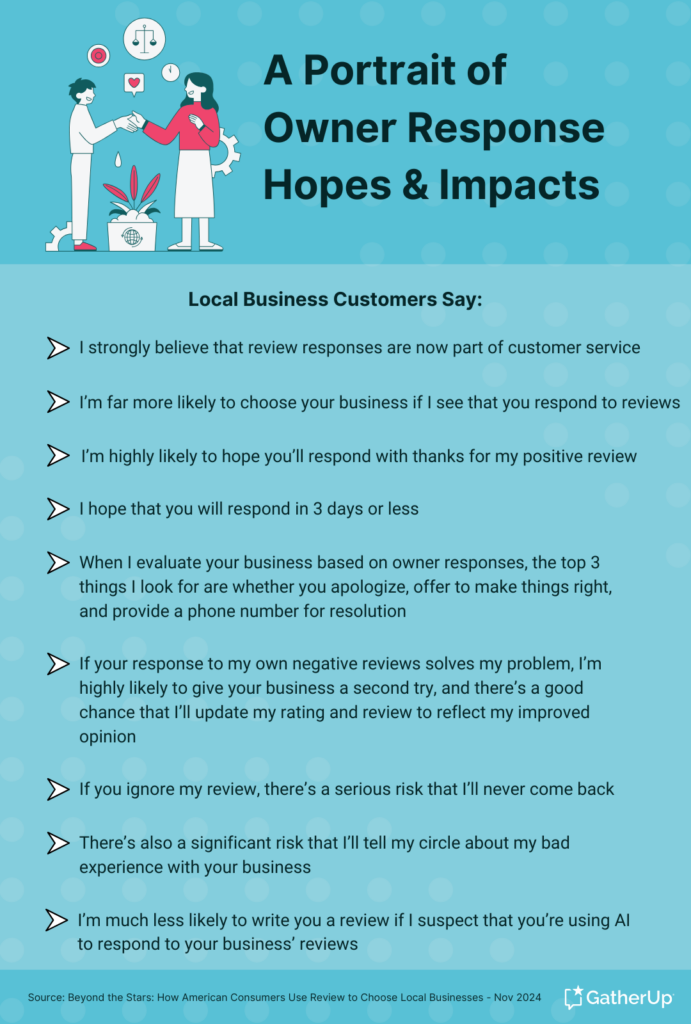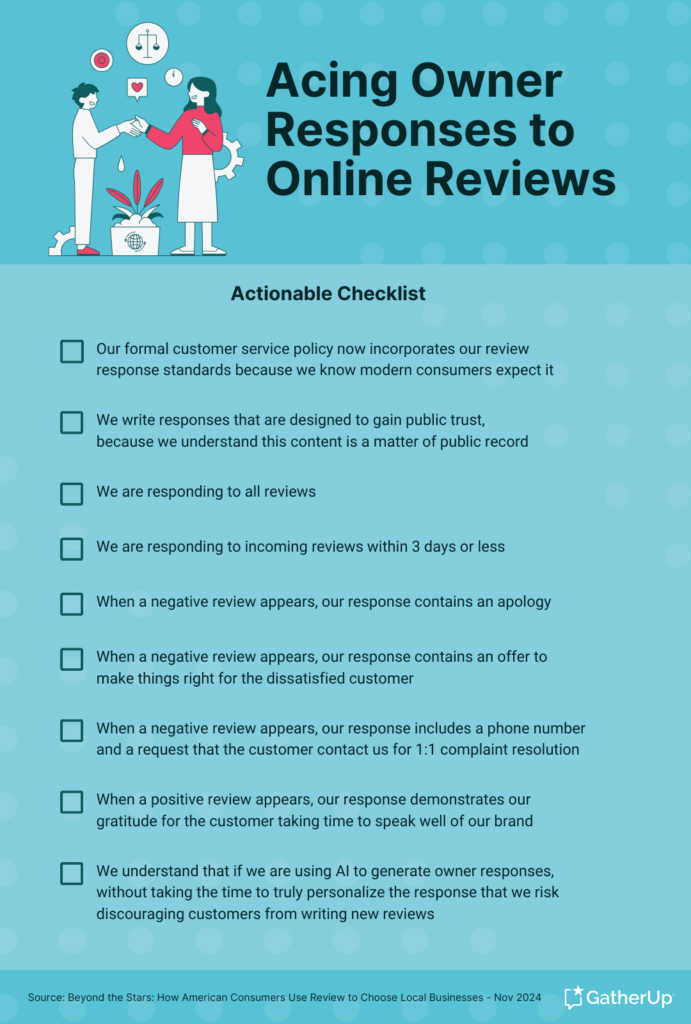
This fourth and final part in our miniseries is based on insights gleaned from our local business review survey of 1,200 US-based consumers and will teach you how to improve the online customer service your brand is providing via excellent owner responses to reviews. Part 1 challenged our assumptions based on age cohorts, part 2 looked at the preferences of review readers and Part 3 examined the habits of review writers. Today, we’ll focus solely on what customers are expecting from you when they review your business.
By basing your owner responses to reviews on data instead of guesses, you’ll be able to please more of your customer base, and even win back the writers of negative reviews with well-crafted replies. Good owner responses are a local business superpower, once you know how to harness it!
Understanding what customers expect from your owner response to reviews
Share this infographic with all stakeholders involved in the reputation management of your company. It paints a simple, data-based portrait of consumers’ hopes when it comes to how you respond to their reviews, as well as how owner responses influence purchasing decisions.

Stats tell the the story of how to meet consumers’ review response expectations
Providing modern customer service
Perhaps no other data point in our survey better encapsulates the offline-to-online transition American consumers have undergone than this finding: 92% now feel that owner responses to reviews have become part of providing good customer service. Independent consumer satisfaction surveys routinely link improvements in customer service quality to increased profits. Thus, learning to see local business reviews as the beginning of a conversation which an individual customer is trying to start with your brand is a good way to ensure that patrons you’ve already earned aren’t feeling ignored. Reviewers have already transacted with your company and are taking to the web to publicize their experience, whether good or bad. These are people and content few brands can afford to neglect, and customer service policies need to be modernized to include swift, professional review responses as a baseline quality and performance metric.
It’s vital to understand that your responses aren’t solely geared towards individual reviewers – they are widely read by the public. 82% of consumers are more likely to choose your business for a transaction if they see that you respond to other customers’ reviews. When you react well to both praise and complaints, it sends a strong signal that your brand is responsive, accessible, and cares about its community.
Meeting local business reviewer expectations
Positive reviews have an outstanding impact on the decision-making of the consumer public. 73% of customers who have taken the time to praise your business in a review appreciate having their efforts acknowledged with a response. This number is even higher when a problem caused the reviewer to complain. 79% of negative reviewers expect an owner response from your brand.
Your business should put a process in place that delivers review responses as quickly as possible. On average, 36% of your customers expect a response within 1 day, and 30% want to hear back within 3 days. Just 20% have the patience to wait for a week. However, these numbers can vary based on the age-range of your community, and you can get additional data about this particular statistical set in Bucking Bias: 10 Age-Based Local Business Review Habits.
Maximizing the influence of owner responses
So much trust is on the line when it comes to how brands like yours respond to negative reviews. When the public evaluates your review responses to see how well you treat fellow customers when something goes wrong, these three elements have the greatest influence on trust:
- 69% of consumers want to see you apologize for a customer’s bad experience; saying “I’m sorry” really matters.
- 67% want to see that your brand is offering to make things right for the dissatisfied customer.
- 42% want to see that you’ve offered a phone number to call for complaint resolution.
Owner responses can become a customer-retention and satisfaction superpower when wielded well. 73% of unhappy customers are willing to give your business a second chance if your response solves their problem, and an additional 54% will update their negative rating and review to reflect that they’ve had a much more positive second experience with your brand. Keeping existing customers happy is far more cost-efficient than having to acquire new customers to replace ones who have been lost to bad customer service.
Taken in conjunction with the finding that the overwhelming majority of Americans now consider owner responses to be part-and-parcel of providing modern customer service, the risks of ignoring reviews are significant. 59% of customers will never give your business a second chance if your brand ignores their negative reviews. 53% are unlikely to recommend your business to their circle because they think it lacks a genuine commitment to providing good customer service. 44% are likely to tell others that they’ve been treated badly by your business. Thankfully all of these negative outcomes can be avoided with a dedicated reputation management program.
Finally, it’s likely that your business is being inundated at present with offers of AI shortcuts to customer service of all kinds. It’s important to know that more than 6 in 10 American consumers say they feel discouraged from writing reviews if they suspect that a brand will reply with an AI-generated response. If the volume of incoming reviews you receive is causing you to consider using AI as part of the response process, you should be carefully monitoring outcomes from the start date of using the product to see if incoming review volumes downtrend. Review count is believed to directly impact local search rankings in Google, and owner responses are a golden opportunity to build real relationships with the people you want to serve. Factor these realities into your evaluation of any AI-base offering.
Acing Owner Responses: An Actionable Checklist
Now that we have a clear view of the expectations of consumers and the influence of owner responses, it’s time to compare your current reputation management process to this checklist. If you can check off all these boxes, you’ve already mastered best practices. If any boxes remain unchecked, you’ll quickly see where you can improve your strategy to deliver more customer satisfaction:
- Our formal customer service policy now incorporates our review response standards because we know modern consumers expect it
- We write responses that are designed to gain public trust, because we understand this content is a matter of public record
- We are responding to all reviews
- We are responding within 3 or less days to incoming reviews
- When a negative review appears, our response contains an apology
- When a negative review appears, our response contains an offer to make things right for the dissatisfied customer
- When a negative review appears, our response includes a phone number and a request that the customer contact us for 1:1 complaint resolution
- When a positive review appears, our response demonstrates our gratitude for the customer taking time to speak well of our brand
- We understand that if we are using AI to generate owner responses, we risk discouraging customers from writing new reviews

Resolving reputation management blockers
The reality is that you can do almost any local search in Google right now and immediately turn up multiple examples of brands neglecting their entire review corpus. Both praise and complaints are going unnoticed by these businesses, and profits are almost certainly sitting unrealized.
From years of consulting with local business owners, three common challenges emerge as the chief causes of costly review neglect:
- The business is so small that the owner is overworked and finding it difficult to make time to monitor and respond to their reviews.
- The business has grown to a multi-location or franchise model, and appropriate access permissions have not been put in place to train and systematize location-level review responses at scale.
- The brand has become so large that care for customer satisfaction has suffered; the current success of the business has misled it into seeing review neglect as an acceptable risk.
In the first instance, we would urge the smallest local business owners to do an audit of how online marketing time is being spent. Reviews have a direct impact on the reputation, rankings, and revenue of your business. Even if you have to steal time away from marketing via your social channels in order to manage review responses, the ROI gains could be worth it. If budget allows, consider an investment in reputation management software like GatherUp. Reviews have such a powerful influence on consumer purchasing decisions that you may need to seriously consider hiring part-time help who can be trained to manage the core customer service duty of providing owner responses.
In the second instance, a solution is within fairly easy reach. GatherUp can help you organize reputation management across all locations of your business, ensuring that you’re alerted to all incoming reviews and engaging swiftly with your customers.
In the third instance, our best advice is to be wary of any policy which de-prioritizes customer satisfaction. Big brands have historically been risk-averse but Google’s local results prove that too many large businesses are ignoring the dangers of review neglect. Unresolved negative reviews quickly erode overall average star ratings and rankings, and there is a time limit to any company riding on brand recognition, alone. If you’re marketing hundreds or thousands of locations and the findings of this survey have inspired a new commitment to providing excellent customer experiences, please request a GatherUp demo to let us show you how we’re helping other large brands build successful reputation management strategies.
Summing Up
In addition to the landmark finding of our formal survey that the overwhelming majority of consumers now regard owner responses as a customer service feature, we’ve codified here that the negative reviews dreaded by so many local business owners are not set in stone.
If your brand develops the skills of responding well to complaints, the majority of customers are quite willing to come back for a second experience, and even to improve your overall average Google star rating by updating their initial rating to accurately reflect their better opinion of your company. Owner responses are, in fact, the most powerful antidote to fear of reviews.
Providing exceptional customer service that earns loyalty and word-of-mouth recommendations is all about giving patrons what they want. You now have data to guide you in writing responses that meet and exceed consumer needs. For further insights, please read our full report, Beyond the Stars: How American Consumers Use Reviews to Choose Local Businesses.
